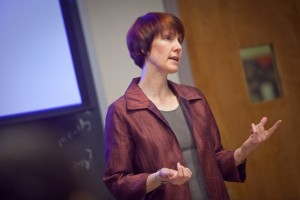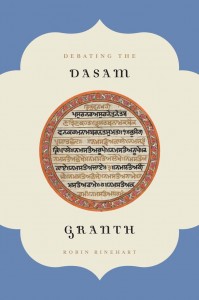
Professor Robin Rinehart
Professor Robin Rinehart has always been fascinated by the interactions among different religions in the Punjab region, divided between India and Pakistan. Having lived on both sides, she became absorbed in the area’s culture and history, so the exploration of the controversial Sikh text the Dasam Granth is a natural extension of her research interests.
Her upcoming book, Debating the Dasam Granth, is the first English language, book-length critical study of the text in years. The Dasam Granth is a 1,428-page text believed to be authored by the tenth Guru of Sikhism, Guru Gobind Singh. Sikhs continue to debate whether it should be considered scripture or literature. Major sources of controversy include the presence of Hindu gods and goddesses as well as graphic tales of illicit liaisons between men and women in the composition Charitropakhian. Many scholars also have called into question whether Guru Gobind Singh authored the entire text.
For her part, Rinehart focuses less on what place the Dasam Granth should occupy in the Sikh religious landscape and more on where it presently fits into Indian society. Noting that the text enjoyed its greatest relevance in the 18th century when there were still Sikh kingdoms, she says it became less relevant in colonial and contemporary India. Still, much debate takes place among the diaspora Sikh community.

Debating the Dasam Granth by Robin Rinehart
“Here’s a text people have the same arguments about over and over and over,” explains Rinehart, professor and head of religious studies and chair of Asian studies. “Let’s leave the controversies aside and see how it fits in Indian literature as a whole. It seems to be an example of the kind of text that was produced at the courts of kings, and it has a lot of connections with earlier forms of Sanskrit literature and what’s called Indian ‘story literature.’”
Rinehart traveled throughout India to gather resources on the Dasam Granth, most of which are published in the Brajbhasha and Punjabi languages. She also discussed the text with university scholars, community leaders, and various Sikhs she met along the way. What she found is that there is a diverse range of opinions about the Dasam Granth and a consensus may never be reached.
Set to be published in December by Oxford University Press, Debating the Dasam Granth offers an in-depth introduction to the Dasam Granth, its history, debates about its authenticity, and detailed analysis of its most important compositions.
Rinehart has published several articles and book chapters on the Dasam Granth. Her first book, One Lifetime, Many Lives: The Experience of Modern Hindu Hagiography, was published by Scholars Press in 1999. She is also the editor of the undergraduate textbook Contemporary Hinduism: Ritual, Culture, and Practice (2004). She has delivered lectures and made conference presentations throughout the U.S. and abroad, including India, Italy, Belgium, Trinidad, and Canada.
A recipient of Lafayette’s Lindback Distinguished Teaching Award and Thomas Roy and Lura Forrest Jones Lecture Award for Excellence in Teaching and Scholarship, Rinehart has advised numerous students through independent study and honors thesis research. She is a member of the American Academy of Religion, Association for Asian Studies, and Mid‑Atlantic Region/Association for Asian Studies, and is co-chair of the Religion in South Asia Section of the American Academy of Religion. She earned her Ph.D. at University of Pennsylvania and master’s and bachelor’s degrees at University of Washington.

